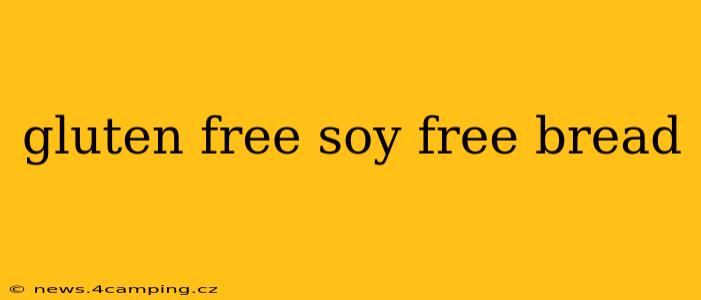Finding delicious bread when you're avoiding both gluten and soy can feel like a culinary quest. Many gluten-free products rely on soy as a binder or protein source, making it challenging for those with soy allergies or intolerances. But don't despair! This comprehensive guide will explore the world of gluten-free, soy-free bread, covering everything from ingredient options to baking tips and troubleshooting common issues.
What are the challenges of making gluten-free soy-free bread?
Gluten and soy both play crucial roles in traditional bread making. Gluten provides elasticity and structure, while soy adds protein and moisture. Removing both requires careful consideration of alternative ingredients that can replicate these properties. This often involves experimenting with different combinations of flours, starches, and binding agents to achieve the desired texture and rise.
What are some good gluten-free and soy-free flour blends?
The foundation of any gluten-free, soy-free bread is the flour blend. Several options exist, each offering a unique texture and flavor profile:
- Brown rice flour: Provides a slightly nutty flavor and some binding properties.
- Tapioca starch/flour: Adds lightness and chewiness but needs other flours for structure.
- Potato starch/flour: Contributes to a soft crumb but can make bread gummy if overused.
- Sorghum flour: Offers a slightly sweet flavor and contributes to the bread's structure.
- Buckwheat flour: Provides a slightly earthy flavor and some binding, although it's technically not a grain. (Note: buckwheat can trigger reactions in some individuals with gluten sensitivity, so proceed with caution.)
- Teff flour: A slightly nutty, nutritious option that helps with binding.
Experimenting with different combinations of these flours is crucial to finding your perfect blend. Many recipes suggest using a mix to achieve optimal texture and rise.
What are good binders for gluten-free soy-free bread?
Binders are key to achieving a cohesive loaf. Since gluten and soy are absent, you need alternatives to hold the bread together. Here are some options:
- Psyllium husk powder: This fiber-rich powder absorbs liquid and helps create structure.
- Xanthan gum: A common gluten-free baking ingredient that improves elasticity and texture.
- Chia seeds or flax seeds (ground): These add moisture and help bind ingredients together.
Remember, using too much binder can result in a dense, gummy loaf, while too little can lead to crumbly bread. Start with the recommended amounts in recipes and adjust as needed based on your flour blend.
Are there specific recipes for gluten-free soy-free bread?
Many recipes are readily available online and in gluten-free cookbooks. Searching for "gluten-free soy-free bread recipes" will yield a variety of options. Remember to carefully check the ingredient lists to ensure they are completely free of both gluten and soy. Pay close attention to potential cross-contamination warnings.
Can I buy pre-made gluten-free soy-free bread?
Yes, several companies now produce gluten-free and soy-free bread. Check labels carefully to confirm the absence of both gluten and soy and also any potential cross-contamination. Be aware that the quality and flavor can vary significantly between brands.
How can I store gluten-free soy-free bread?
Proper storage is crucial to maintain the freshness and quality of gluten-free, soy-free bread. Store it in an airtight container at room temperature for a few days, or freeze it for longer storage. Freezing helps maintain the texture and prevents staleness.
What are common mistakes when making gluten-free soy-free bread?
- Using too much or too little liquid: This directly impacts the texture. Follow the recipe closely and adjust as needed based on the flour blend you use.
- Not letting the dough rest: Allowing the dough to rest after mixing helps the ingredients hydrate and creates a better texture.
- Baking at the wrong temperature or for the wrong time: This can result in a dry, crumbly loaf or a gummy one. Follow the recipe's instructions carefully.
- Using low-quality ingredients: The quality of your ingredients directly impacts the taste and texture of your bread.
Making gluten-free and soy-free bread requires some experimentation, but the results are well worth the effort! With patience and careful attention to detail, you can enjoy delicious homemade bread that fits your dietary needs. Remember to always read labels carefully and consider potential cross-contamination.
